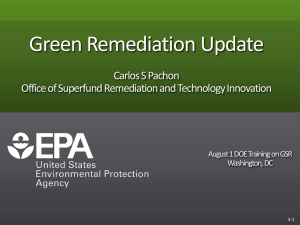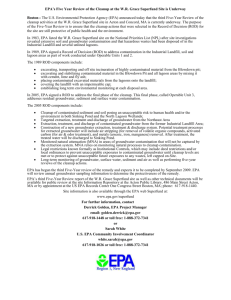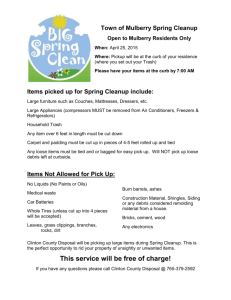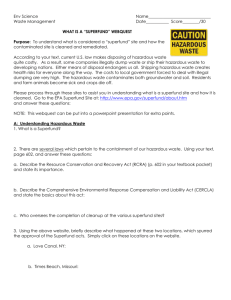Field-Based Site Characterization Technologies Short Course
advertisement
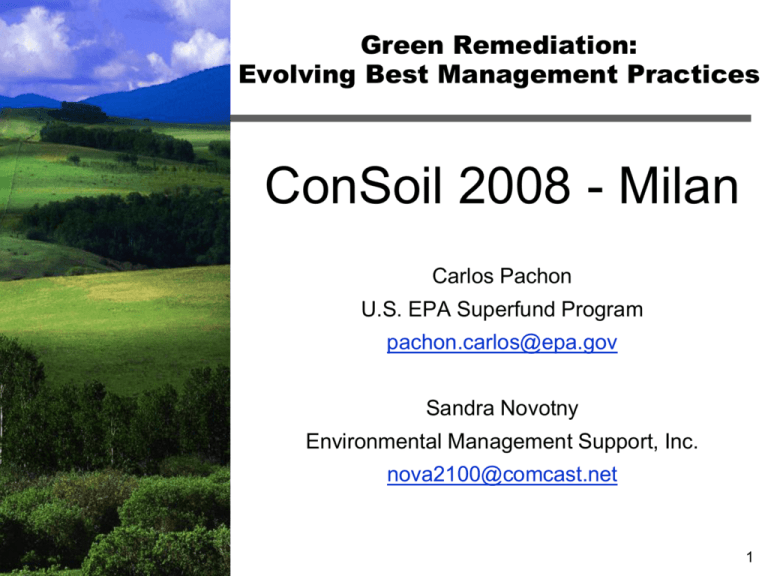
Green Remediation: Evolving Best Management Practices ConSoil 2008 - Milan Carlos Pachon U.S. EPA Superfund Program pachon.carlos@epa.gov Sandra Novotny Environmental Management Support, Inc. nova2100@comcast.net 1 Presentation Topics Environmental management in the U.S. EPA overview of sustainability The role of green remediation in sustainability Best management practices in the field Site-specific applications of green remediation strategies Approaches for reducing energy consumption during site cleanup Incentives, barriers, and efforts to foster green remediation 2 Environmental Management in the U.S. EPA: environmental quality (air, water, soil) Department of Interior » Fish & Wildlife Service » BLM, BuREC: public land management » National Park Service Department of Agriculture » National Forest Service Department of Commerce » National Oceanic & Atmosphere Agency Department of Defense » U.S. Army Corps of Engineers 3 About the Environmental Protection Agency 4 Contaminated Site Cleanup Markets in the U.S. Five major cleanup programs, or market segments 1. Federal facilities, mainly Department of Defense and Department of Energy 2. “Superfund” sites with hazardous waste posing risk to human health and/or the environment 3. Regulated “RCRA” hazardous waste management facilities requiring corrective actions 4. Sites contaminated by underground storage tanks 5. Brownfields and land remediated under State programs 5 What Is “Sustainability”? To create and maintain conditions, under which humans and nature can exist in productive harmony, that permit fulfilling the social, economic, and other requirements of present and future generations — U.S. Presidential Executive Order of 2007 6 What is “Green Remediation”? The practice of considering all environmental effects of remedy implementation and incorporating options to maximize the net environmental benefit of cleanup actions — U.S. EPA Office of Solid Waste and Emergency Response 7 Sustainable Practices for Site Remediation Consider all environmental effects of remedy implementation Use natural resources and energy efficiently Use a holistic approach to site cleanup that reflects reuse goals Minimize cleanup “footprints” on air, water, soil, and ecology Reduce greenhouse gas emissions contributing to climate change Return formerly contaminated sites to long-term, sustainable, and productive use 8 Integration of Green Remediation in Site Revitalization Sustainable strategies carry forward throughout stages of land revitalization Remediation decision-makers consider the role of cleanup in community revitalization Revitalization project managers maintain an active voice during remediation 9 Opportunities to Increase Sustainability of Cleanups Apply to all cleanup programs within U.S. regulatory structure Exist throughout site investigation and remedy design, construction, operation, and monitoring Address core elements of green remediation 10 Current Practices Increasing energy efficiency Conserving water Improving water quality Managing and minimizing toxics Managing and minimizing waste Reducing emission of greenhouse gases and toxic or priority air pollutants 11 Current Practices (continued) Many strategies of green remediation already used to a degree but not labeled “green” » Using drought resistant and hardier native plants instead of non-native plants » Re-injecting treated water for aquifer storage instead of discharging to surface water » Choosing passive sampling devices when possible, reducing subsurface invasion and waste generation » Minimizing bioavailability of contaminants through source and plume controls 12 High Performance Criteria of New Programs U.S. Green Building Council LEED rating system on new and existing building construction; water examples » Reducing runoff by 25% at sites with impervious cover exceeding 50% » Capturing 90% of site’s average annual rainfall » Removing 80% of suspended solids load based on pre-construction monitoring » Replacing 50% of potable water used at site with nonpotable water 13 High Performance Criteria of New Programs (continued) “Low impact development” designs for stormwater control that aligns with natural hydraulic conditions » Installing engineered structures such as basins or trenches » Routing excess runoff in swales or channels » Storing captured runoff in cisterns or vegetated roofs » Designing redevelopment with clusters, shared transportation, and reduced pavement 14 High Performance Criteria of New Programs (continued) EPA’s GreenScapes for landscaping to preserve natural resources U.S. Department of Energy/EPA’s Energy Star® ratings for energy efficient products and building designs EPA’s WaterSense partnership for water efficient products and labeling Smart Growth principles to reduce urban sprawl 15 Thinking “Outside the Box” Incorporate novel strategies beyond program requirements, such as using » Local materials » Passive lighting » Natural shading for cooling » High thermal mass or reflective material for heat retention 16 Core Elements: Energy Requirements Optimized passive-energy technologies with little or no demand for external utility power, such as gradientdriven permeable reactive barriers Energy-efficient equipment operating at peak performance Renewable energy systems to replace or offset consumption of grid electricity Periodic evaluation and optimization of equipment in systems with high energy demand, such as pump and treat, thermal desorption, and soil vapor extraction 17 Profile of Energy Conservation: Operating Industries Landfill, CA Remediating soil and ground water contaminated by 59hectare landfill Converting landfill gas to electricity for onsite use Using six 70-kW microturbines to collect landfill gas at rate of 156 m3/min 18 Profile of Energy Conservation (continued) Addresses landfill gas content of 30% methane, 23 times higher global warming potential than carbon dioxide Returns microturbine emissions to gas treatment system to ensure contaminant removal Meets about 70% of plant needs including energy- intensive thermal oxidizer, refrigeration units, and air exchange systems Provides savings of $400,000 each year through avoided grid electricity 19 Core Elements: Air Emissions Optimized maintenance of vehicles and equipment Cleaner fuel and retrofit diesel engines to operate heavy machinery Modified activities to reduce operating time and idling Reduced atmospheric release of toxic or priority pollutants (ozone, particulate matter, carbon monoxide, nitrogen dioxide, sulfur dioxide, and lead) Minimized dust export of contaminants Passive or renewable energy to treat or polish air emissions 20 Profile of Passive Air Treatment: Ferdula Landfill, Frankfort, NY Relies on wind power drawing vacuum from 1hectare landfill to extract TCE from unsaturated portions of landfill Uses one windmill generating 2.4 m3/hr of vacuum per mph of wind Operates totally off-grid, using wind intermittency to provide pulsed effect 21 Profile of Passive Air Treatment (continued) Reduced VOC concentrations in soil gas more than 90% over five years Removed 1,500 pounds of total VOC mass over same period Recovered $14,000 capital cost for wind system within one year due to avoided electricity Cost a total of $40,000 for construction, in contrast to estimated $500,000 for traditional air blower system Accrues annual O&M costs below $500, in contrast to potential $75,000 for conventional soil vapor extraction 22 Core Elements: Water Requirements and Resources Minimum fresh water use and maximum reuse during daily operations and treatment processes Reclaimed treated water for beneficial use or aquifer storage Native vegetation requiring little or no irrigation, with methods such as drip-feed where needed Prevention of water quality impacts such as nutrient- loading Stormwater management strategies increasing subsurface infiltration, limiting disruption of natural hydrology, and reducing runoff 23 Profile of Water Resource Protection: Old Base Landfill, MD Used BMPs for controlling runoff and erosion from 29,000-m3 landfill with hazardous waste Emplaced erosion-control blankets to stabilize slopes during cover construction Installed silt fence and chain-backed “super silt fence” at steep grades to protect surface water 24 Profile of Water Resource Protection (continued) Constructed berms and surface channels to divert excess stormwater to ponds Captured sediment at supersilt fence despite heavy rain of Hurricane Floyd Avoided damage to infrastructure used in site development Hydroseeded with native plants, reestablishing 100% vegetative cover within one year Complemented site revitalization as new office and light industrial space opening this year 25 Core Elements: Land and Ecosystems Minimally invasive in situ technologies for subsurface treatment Passive energy technologies such as bioremediation and phytoremediation as primary remedies or “finishing steps” Minimized bioavailability of contaminants through high degree of contaminant source and plume controls Increased opportunities for carbon sequestration Adoption of ecorestoration and reuse practices Reduced noise and lighting disturbance Minimal disturbance to surface soil and wildlife habitats 26 Profile of Land/Ecosystem Protection: California Gulch Superfund Site, CO Addressed high metals in soil while creating recreational opportunities in former mining area Built trail of consolidated slag covered by gravel and asphalt Avoided invasive and costly excavation in hardrock area at 3,000-m elevation of Rocky Mountains 27 Profile of Land/Ecosystem Protection (continued) Conducted risk assessment confirming interception of contaminant exposure pathway to trail users Avoided transportation costs and greenhouse gas emissions for offsite disposal of metals-contaminated soil Reduced need for imported “new” material by using contained “waste in place” Relied on extensive input from community, financial contributions from landowners, and long-term maintenance by local government Fostered community end use based on recreation and tourism 28 Core Elements: Material Consumption and Waste Generation Minimum extraction and disposal of natural resources Enhanced recovery of metals or other resources with potential market value Selection of treatment equipment and sampling devices designed to minimize waste generation Maximum reuse of construction and demolition debris such as concrete, wood, and bricks Maximum recycling of routine material such as plastic, glass, and cardboard 29 Profile of Material/Waste Reduction: Grove Brownfield, TX Constructed an innovative 1.2-m evapotranspiration cap containing 3,800 m3 of mixed debris at illegal dump Powered cleanup equipment through use of PV panels due to initial lack of grid electricity Recycled 32 tons of metal recovered onsite Extracted 680 tires through use of vegetable oil-powered tractor Shredded onsite wood to create mulch for recreational trails Inoculated chainsaws with fungi spore-laden oil to aid degradation of residual contaminants 30 Profile of Material/Waste Reduction (continued) Salvaged concrete for later use as construction fill for onsite building Constructed floating islands of recovered plastic to create wildlife habitat Transformed the property within one year with help from local volunteers Created an environmental education park 31 U.S. Superfund Program Energy Use Over 14.2 billion kWh of electricity to be used by five common cleanup technologies through 2030 under U.S. Superfund Program Over 9.3 million metric tons of carbon dioxide emission expected from use of these technologies over same time Emissions equivalent to operating two coal-fired power plants for one year Cost of fossil fuel consumed by these technologies at sites on the Superfund National Priorities List exceeds $1.4 billion from 2008 through 2030 32 Superfund Cleanup Technologies Technology Estimated Energy Annual Average (kWh*103) Total Estimated Energy Use in 2008-2030 (kWh*103) Pump & Treat 489,607 11,260,969 Thermal Desorption 92,919 2,137,126 Multi-Phase Extraction 18,679 429,625 Air Sparging 10,156 233,599 Soil Vapor Extraction 6,734 154,890 Technology Total 618,095 14,216,209 33 Energy and Efficiency Considerations Significant reductions in fossil fuel consumption possible » Greater efforts to optimize treatment systems » Use of alternative energy from natural, renewable sources such as solar and wind resources Electric power production accounts for 1/3 of carbon dioxide emissions in the U.S. energy sector 34 Optimizing Energy Intensive Treatment Systems Compare environmental footprints expected from potential cleanup alternatives » Greenhouse gas emissions » Carbon sequestration capability » Water drawdown Design treatment systems without oversized equipment or operating rates and temperatures higher than needed Evaluate existing systems periodically to find opportunities for reducing consumption of natural resources and energy 35 Optimization Examples Insulate structural housing and equipment Install energy recovery ventilators Weather-proof outdoor components Recycle process fluid, byproducts, and water Reclaim material with resale value Install automatic water shut-off valves Frequently re-evaluate efficiency of pump and treat systems Operate soil vapor extraction systems with pulsed pumping during off-peak hours of electrical demand 36 Profile of System Optimization: Havertown PCP Site, PA Remediating shallow ground water containing metals, VOCs, and benzene Uses four recovery wells and one collection trench Pretreats extracted ground water to break oil/water emulsion, remove metals, and remove suspended solids Employs pump and treat system of UV/OX lamps, peroxide destruction unit, and granular activated carbon Took two UV/OX lamps offline after comprehensive evaluation of ongoing system Reduced annual operating cost by $32,000 due to optimized electricity consumption 37 Renewable Energy Considerations Resource assessment of availability, reliability, and seasonal variability Total energy demand of the treatment system Proximity to utility grids and related cost and time for connection Back-up energy sources for treatment or safety Cost tradeoffs associated with cleanup duration and scale of energy production Long-term viability and potential reuse of renewable energy system 38 Profile of Integrated Renewable Energy Systems: St. Croix Alumina, VI Supports recovery of oil refinery hydrocarbons from ground water in coastal area Relies on hybrid solar and wind system capable of expansion for new needs Uses 385-W PV solar array to generate electricity for fluid gathering system 39 Profile of Integrated Renewable Energy Systems (continued) Wind-driven turbine compressors drive air into hydraulic skimming pumps Wind-driven electric generators power pumps recovering free-product oil Recovered 864,000 liters (20%) of free-product oil over four years Adjacent refinery uses reclaimed oil for feedstock 40 Profile of Solar Energy Application: Fort Carson, CO Cleanup of over 170 waste areas at military facility in semi-arid setting at 1,780-m elevation 5-hectare landfill covered by evapotranspiration cap of local soil and plants 2-MW solar system installed in 2007, as largest array in U.S. Army complex 41 Profile of Solar Energy Application (continued) Arranged through power purchase agreement » Third-party investment financing » Corporate energy ownership of renewable energy credits gained by construction and operation » Military leasing of land, in return receiving long-term reduced rates for electricity purchase from utility Contributes to State of Colorado requirements for 10% of its utility power to be generated through renewable resources, including 4% solar energy 42 Profile of Wind Energy Application: Former Nebraska Ordnance Plant, NE Supports aboveground air stripping to treat ground water containing TCE and explosives Uses a 10-kW wind turbine to power ground water circulation well Relies on average wind speed of 6.5 m/sec, as estimated in U.S. Department of Energy’s Wind Energy Resource Atlas 43 Profile of Wind Energy Application (continued) Tests were conducted in off-grid and grid inter-tie modes to evaluate potential for meeting monthly demand of 767 kWh Average daily energy consumption from utilities decreased 26% during grid inter-tie phase Monthly emissions of carbon dioxide averaged 24 - 32% lower during grid inter-tie phase Surplus electricity returns to grid for other consumer use Net capital costs totaled approximately $40,000, including turbine installation and utility connection Tests showed improved freeze-proofing of wells could cut turbine cost-recovery time in half 44 Advancing Green Remediation Practices: EPA Efforts Documenting state-of-the-art BMPs Identifying emergent opportunities Establishing a community of practitioners Developing mechanisms and tools » Pilot projects for renewable energy production on contaminated lands » Standard contract language for cleanup services » Self-auditing checklists of best practices » Automated energy calculators 45 Opening Doors for Best Management Practices in the Field Document sustainable strategies and success measures in site management plans and daily materials Require contract bids for equipment and products to specify » Efficiency and reliability » Fuel consumption and air emissions » Rates of water consumption » Material content, including recycled and biobased components 46 Incentives and Barriers Demonstrations or cost sharing under federal programs or organizations such as » EPA’s Climate Change Program » The National Renewable Energy Laboratory State programs such as the CA Self Generation Incentive Program for distributed energy production New municipal ordnances and partnerships with local businesses and non-profit groups Evolving methods to resolve actual or perceived barriers » Initial “learning curves” of stakeholders » Lack of capital-cost recovery plan over time 47 Green Remediation Primer Released April 2008, available free online Provides introduction to BMPs, with examples of how and where they are used Describes sustainable aspects of commonly used or emerging cleanup technologies Focuses on remedy implementation across regulatory frameworks 48 Information Resources EPA is compiling information on sustainable cleanups from various federal or state regulatory programs and agencies Bundled information is available online at “GR Web www.clu-in.org/greenremediation pachon.carlos@epa.gov 49

